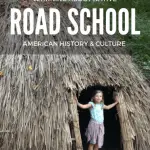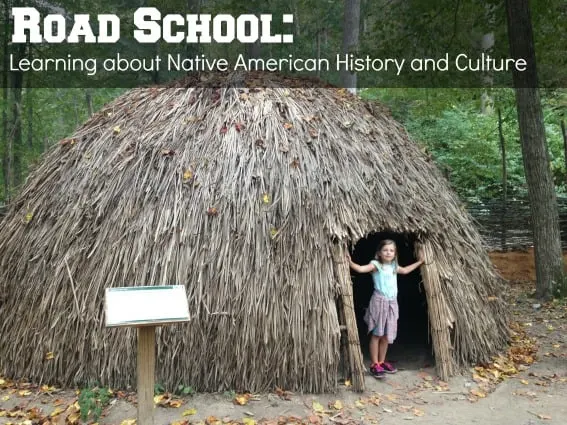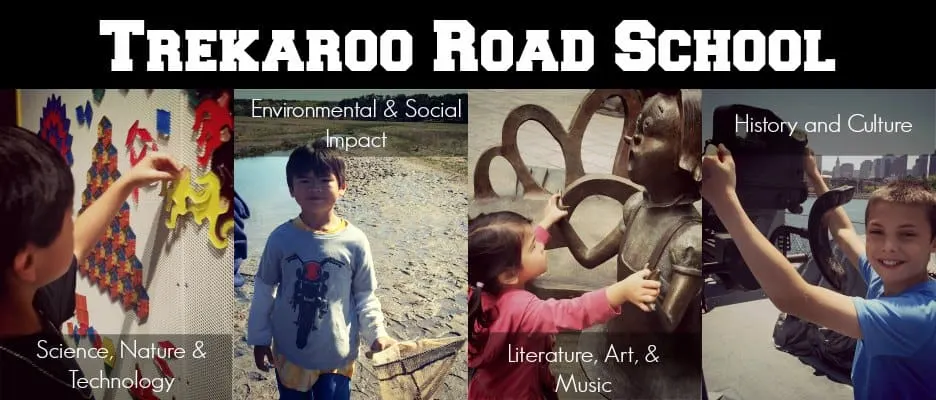The stories of the Native American people, both past and present, are told at many historic sites and museum across the United States and Canada. Families don’t have to travel far to visit the reconstructed or original dwellings of the people that lived in America long before Columbus arrived on this side of the Atlantic. As my family has traveled across the country, I have often considered how best to use our visits to Native American historical sites to teach my kids to respect cultures and religious beliefs that are different from their own and to provide them with an accurate account of Native American history.
Making the Most of Your Visit to Native American History Sites and Museums
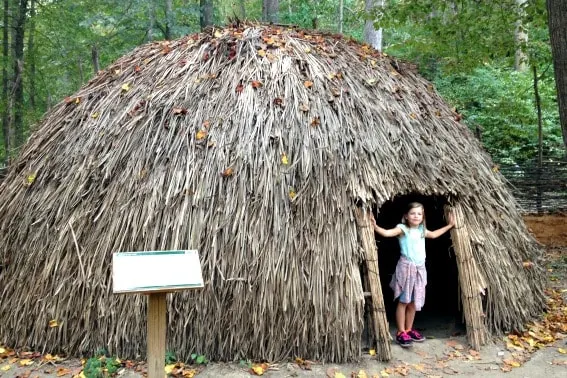 Photo by Melissa Moore
Photo by Melissa Moore
Based on what my husband and I know about our family histories, it is very likely that at least a couple branches of our family tree are of Native American heritage; however, those traditions in our family have been lost to us. Admittedly, I know little more of Native American customs than what I learned in my history classes at school and what I have learned in my travels. Finding museums and historical sites that represent the voices of the Native American people are a vital piece of the puzzle in educating my kids about both their own ancestry and the history of their country.
Historic Sites and Monuments – Multiple Perspectives to Consider
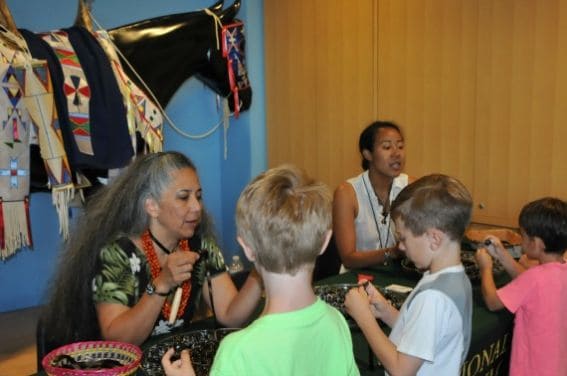 Photo Courtesy of the National Museum of the American Indian
Photo Courtesy of the National Museum of the American Indian
In 2015, my family visited the original site of historic Jamestown on the anniversary of its founding, Jamestown Day. Based on what I had read about the site, I was simply expecting to find ruins, monuments, and on-going archaeological investigations. Yes, my kids were able to learn a bit about archaeology. However, on our way out to the museum, we found a large crowd of people listening to a man telling the legends of the Native Americans who had lived in the area before Captain John Smith had arrived, and we stopped to listen for a bit. My kids are always captivated by legends that describe familiar animals, constellations, or geographic formations in a new light.
I am reminded through my family’s experiences visits to historic sites, such as Jamestown, that my children are fortunate to live in a time and place where they can learn about American history from multiple perspectives. In the morning of our visit to Jamestown, our family walked through the museum at Jamestown Settlement and read excepts from Captain John Smith’s journals about the Powhatan people, and in the afternoon, we heard of the Powhatan’s legends firsthand from a likely descendant. These perspectives, while different, are both vitally important parts of American history.
Local and Regional Museums – A Personal Connection with History
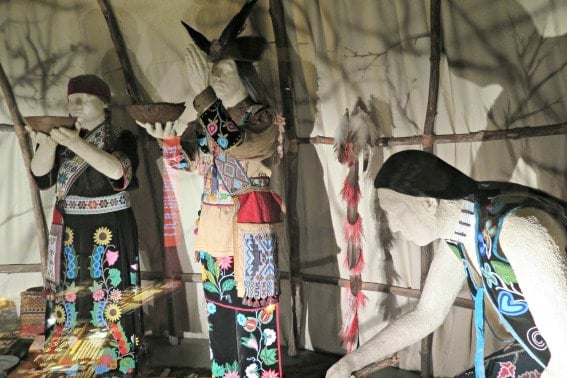
Photo by: Melissa Moore
Our family has visited local history museums across America from Virginia to California. Most of these museums have at least a small selection of Native American arrowheads and artifacts with a corresponding map describing the historic locations of the regional tribes. It’s important to remember that no matter where your family lives, there is likely a resource for learning the region’s history right in your own backyard. Not only are these local museums a great resource for viewing local artifacts, but typically local retirees are on hand as docents to tell the stories of past, especially on a day when special activities are planned. To this day, I remember a childhood visit to my hometown local historical society where a grandmotherly lady told the story of how our small town was named “Carpinteria” by the Spaniards after the local Chumash Indians who were “carpenters” and built canoes out of trees and tar from the nearby beach.
Living History Museums – Engaging History for All Ages
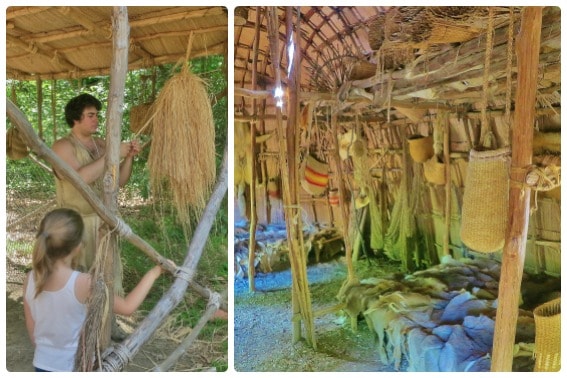 Photo by: Melissa Moore
Photo by: Melissa Moore
Living history sites like those that Jamestown Settlement and Plymouth Plantation are certainly able to engage young learners in a historic time period like little else can. I have to admit that seeing pale-skinned college students painted and dressed as Native Americans at Jamestown Settlement was a bit odd; however, those college students did do a great job of sparking my children’s interest in the diet of 17th century Native Americans in Coastal Virginia, and my kids were kept busy in the car “making rope” long after pulling out of the parking lot. Once a child’s interest is sparked, they often choose own their own to pursue their new interest or at least can be more easily prompted to read more about the topic. While it’s beyond the ability of a living history site to give a completely accurate portrayal of life over 500 years ago, parents can complement that visit with additional learning resources that can provide a more complete picture. A great place to get started is with Trekaroo’s Native American History and Culture Pinterest Board.
Places to Visit Across America to explore Native American History
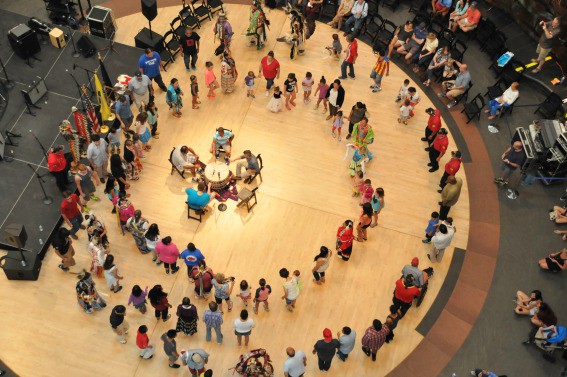 Photo Courtesy of the National Museum of the American Indian
Photo Courtesy of the National Museum of the American Indian
Upon walking through the “Nation to Nation” exhibit on treaties between the United States and Native American Indian tribes on my most recent visit to the National Museum of the American Indian, I realized that I was quite familiar with with the history of the Native American tribes of my home state, California, but quite unfamiliar with the histories of the tribes in regions such as the Great Lakes. Many students in the United States learn about local and regional Native American tribes in their 4th grade history classes. While learning to identify with the culture of the people who have lived in the local area for centuries is a great thing, students may not spend as much time learning about the bigger picture of Native American history across America.
Travel gives families the opportunity to learn about tribes and historical events that they may previously have heard only a bit about in school. Many of the Native American Indian tribes that inhabited the Mid-Atlantic coast when European colonists first began arriving in America have an impressive history of forced and “voluntary” relocations across the continent as well as a long history of successful and failed treaties with the United States government. Families who travel can learn to identify with these people groups as they see how the tribes culture was forced to adapt as they moved west. Of course, the striking variety of local legends, dwellings, and dress also becomes more apparent as families visit historic sites and museums across the country.
National Museum of the American Indian and Mitsitam Native Foods Cafe in Washington DC
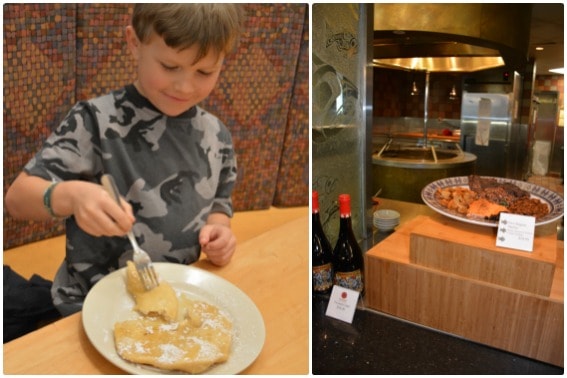
Photo by: Melissa Moore
Since moving to the Washington DC area, I have spent many hours with my kids learning about the people groups native to the Americas at the National Museum of the American Indian. According to their website, the museum is “steadfastly committed to bringing Native voices to what the museum writes and presents…” The museum is known for being one of the museums on the National Mall that provides a hands-on, family-friendly area, the imagiNATIONS Activity Center, which hosts activities including music programs and storytelling session in addition to its hands-on learning activities like a huge interactive model of basket weaving. The museum also has a large area in the lobby where there are often handmade Native gifts for sale or Native dancers preforming.
One of the highlights of the National Museum of the American Indian is its cafeteria-style restaurant, the Mitsitam Native Foods Cafe. The restaurant is like a culinary tour of the Native American regional groups represented in the museum upstairs. Yes, my young children are a bit too cautious to sample many of the foods, especially those made with unfamiliar ingredients like bison. However, the entire family agrees that the traditional fry bread is worth the walk from anywhere on the National Mall. What better way to experience a culture than to taste its food?
Canada and Alaska
 Photo by: Melissa Moore
Photo by: Melissa Moore
In my many visits to Winnipeg, Manitoba, I have found a city that takes time to educate its citizens and visitors about its past as a diverse trade center among Canada’s First Nations. Winnipeg is located on the Red River directly north of North Dakota and fully embraces it’s heritage as a confluence of peoples and traditions. The Forks, the geographic location where the Assiniboine River meets the Red River, is a place where people have been meeting to trade for at least a thousand years. Now The Forks it is home to many of the top attractions in Winnipeg, including the Forks Market, the Canadian Museum of Human Rights and the Forks National Historic Site managed by Parks Canada. Inside the Forks National Historic Site is one of the most brilliantly designed playgrounds that my family has ever experienced, the Heritage Adventure Park, which tells the story of the history of Manitoba through interactive playground structures. At the playground, children can learn about the many ways that the First Peoples from this area, including the Cree and Ojibway, used bison and other animals for survival. The family-friendly Canadian Museum of Human Rights, recently opened in the fall of 2014, highlights the history of the region in its Indigenous Perspectives Gallery on Level 2; in that gallery children are invited to watch a film about Indigenous ways of viewing rights and responsibilities and touch a beadwork sample made by the local Metis people.
The totem poles common to the First Nations in the Pacific Northwest, especially British Columbia and Alaska, are some of the most intriguing Native American artwork due to the way that they tell the stories and legends of the people. Trekaroo families have enjoyed learning about the history of the First Nations of British Columbia at Totem Park and Museum of Anthropology in Vancouver. Families visiting Sitka, Alaska also have the opportunity to learn about totem poles at Sitka National Historic Park.
California

Photo by: Melissa Moore
Most California students spend their fourth grade year learning about the history of the missions built by the Spaniards for the purpose of converting the coastal Native American population to Catholicism in the late 18th Century. Students are often required to build a model of a mission, visit a mission, and write a report. While many of the missions are still functioning churches, the La Purisima Mission just outside of Lompoc has been a state historic park since my own childhood years. For a picture of what what life might have been like for the local Chumash Indians both before the arrival of the Spaniards and after the mission was constructed, families can step back in time at La Purisima Mission State Historic Park; be sure to check the calendar before your family’s visit for special living history events. The docents at La Purisma can also give families directions for hiking to the various Chumash Painted Caves between Santa Ynez and Santa Barbara; these decidedly off-the beaten-path historic sites are also managed by the California State Park system.
In Northern California, families can visit the California State Indian Museum, Indian Grinding Rock State Park or even Yosemite National Park to learn more about the Native Americans that lived in the Sierras before the Forty-Niners arrived in search of gold. The Indian Village of the Ahwahnee in Yosemite includes reconstructed cedar bark homes that were often used by the Miwok people before the Euro-Americanized cabins became more popular in the mid-1800s; kids loved to play in these structures while they imagine what life might have been like in the Yosemite Valley hundreds of years ago. The Ceremonial Roundhouse on this site was constructed in 1992 and is now used by the local Native American tribes; it is generally off-limits to tourists, but it is a great reminder that Native American culture and traditions live on in the local area.
Colonial America
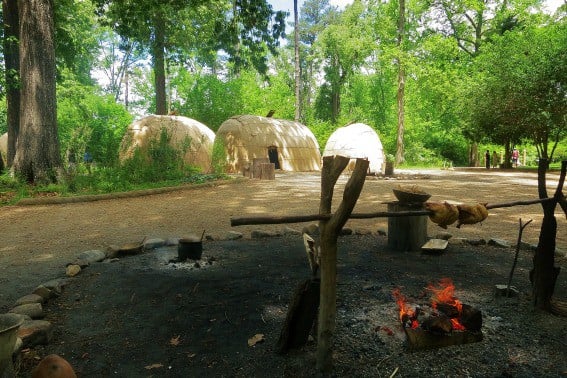
Photo by: Melissa Moore
In many cases the first English settlers in colonial America benefited from the Native American tribes along the Atlantic coast as the Native Americans generously showed them how to survive in a new land. However, by the mid-17th century, the Native American tribes were in a battle to keep lands that already had been set aside in treaties. Ultimately, much of the Native American population moved west or were lost to disease.
The living history sites and museums that in recent years have been created to tell the story of the region’s Native American people are based largely on information gathered through archeology and first hand accounts rather than existing sites and dwelling as is the case in the West. The living history sites at Jamestown Settlement, Plymouth Plantation and the Monacan Indian Village at Natural Bridge are all excellent places to introduce kids to the traditions of the Native Americans who lived in this region up until the 17th and 18th centuries. The museum at Jamestown Settlement has a notable exhibit on Pocahontas perfect for kids who want to learn about the history behind this well-known tale.
The Southwest
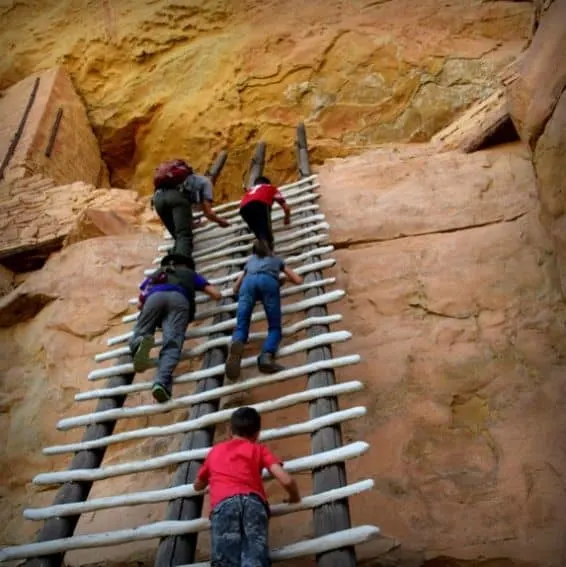
Photo by: Sharlene Earnshaw
New Mexico, Arizona and Utah are home to three of America’s largest Indian reservations, including the Navajo Nation, established as part of a 1868 treaty and now covering over 27,000 square miles of land in the Four Corners region. There are many sites within the Navajo Nation that are worth a visit if your family is driving through the Southwest including the Explore Navajo Interactive Museum.
Trekaroo families love learning about the history of the Native Americans of the Southwest at the many national parks and monuments that preserve historic dwellings. While there are sites all over Arizona and New Mexico, one of the most fun sites to explore is Mesa Verde National Park, founded in 1906 as one of the first national parks whose primary mission was to “preserve the works of man.” The dwellings of Mesa Verde, which families can explore on various park tours, have not been inhabited for almost a thousand years; however, archaeologists have been able to learn quite a bit about the lifestyle of the ancient Pueblo people based on what was left behind. Many of the current Pueblo tribes in the Santa Fe, New Mexico trace their lineage back to the site at Mesa Verde.
The Cherokee People and the Trail of Tears

Photo by: Trekaroo/Smartlilcookie
Just outside of one of America’s mots popular national parks, Great Smoky Mountains National Park, is the town of Cherokee, North Carolina. Cherokee is home to the family-friendly Oconaluftee Indian Village, Museum of the Cherokee Indian, and outdoor drama “Unto These Hills.” Together these attractions aim to educate families about the rich Cherokee cultural heritage of this mountain region; Trekaroo families especially recommend the entertaining and educational drama which tells the story of the Trail of Tears.
As families drive across the Southern states between North Carolina and Oklahoma, they will find many memorials and historic sites that tell the story of Trail of Tears, the forced relocation of thousands of Native Americans due to the Indian Relocation Act of 1830. In Georgia, the Chief Vann House Historic Site tells the story of the family of a Cherokee Indian leader who had to leave their home in Georgia for Oklahoma in the 1830s. About an hour north of Chattanooga, the Cherokee Removal Memorial Park has been set aside to remember the thousands of Native Americans who camped along the river as they set out on their tragic journey west. There are in fact dozens of sites along the Trails of Tears National Historic Trail where families can stop to learn more about this infamous historic event and the Cherokee Nation.
Educational Resources
Elementary School Resources – Picture Books
Middle School and Upper Elementary Resources
Looking for more in our Road School Series? Check out this landing page with links to all of our Road School Guides.


